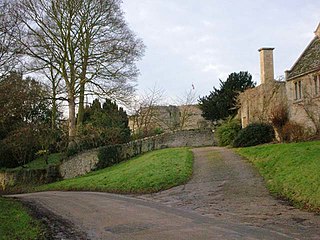
Barnwell Castle is a ruined castle, south of the town of Oundle, and west of the village of Barnwell, Northamptonshire. It has been designated by English Heritage as a Grade I listed building, and is a Scheduled Ancient Monument.
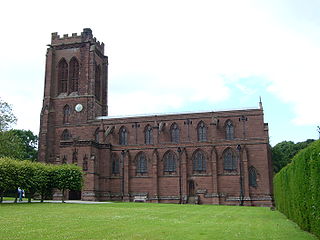
Eccleston is a village and former civil parish, now in the parish of Eaton and Eccleston, in the borough of Cheshire West, in the county of Cheshire, England. The village is approximately 2.7 miles (4.3 km) to the south of the city of Chester, near to the River Dee. The village is situated on the estate of the Duke of Westminster who maintains his ancestral home at nearby Eaton Hall.

Christchurch Castle is located in Christchurch, Dorset, England. The earliest stonework has been dated to 1160. It is a Norman motte and bailey castle. The castle's site is inside the old Saxon burh dominating the River Avon's lowest crossing.
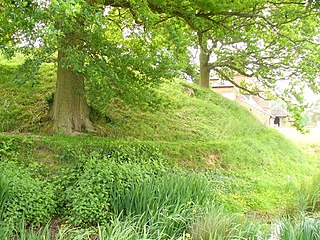
Abinger Castle is an earthwork motte and bailey that was topped with a small wooden fortress. It is located in Abinger Common, between Guildford and Dorking in Surrey, England.
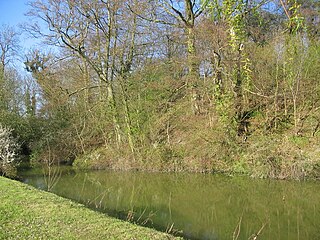
Anstey Castle was in the village of Anstey, Hertfordshire. It was a 12th-century stone motte and bailey fortress that, according to tradition, was founded by Eustace II, Count of Boulogne. It was either him, or one of his immediate progeny who established the first earthwork castle here. The castle had most probably been in existence for some time when the estate was acquired by Geoffrey de Mandeville, for he sought to strengthen his estate in the surrounding valley. It passed into the hands of the de Anstey family in the middle of the 12th century and was strengthened during the First Barons' War of 1215–1216 by Nicholas de Anstey, an opponent of King John, fighting for the barons. After the war ended de Anstey was commanded in 1218 to destroy the castle, with only those parts to remain that had been built before the war. The material from this demolition was supposed to be used in order to repair the nearby church, therefore the crest and shield from the castle feature in the church graffiti.

Barwick-in-Elmet Castle was a fortification in the village of Barwick-in-Elmet, West Yorkshire, England to the east of Leeds.
Bromwich Castle was a motte castle in the large village now called Castle Bromwich in the West Midlands. Bromwich Castle is a scheduled monument.
Castlethorpe Castle stood in the village of Castlethorpe, to the north of Milton Keynes, Buckinghamshire.

Crewkerne Castle was possibly a Norman motte and bailey castle on a mound that is situated north-west of the town of Crewkerne in Somerset, England.

Groby Castle is situated in the large village of Groby to the north-west of the city of Leicester.
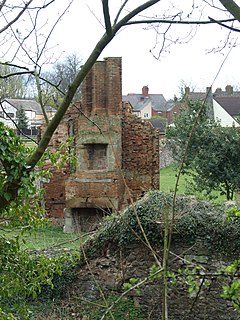
Hartshill Castle is a ruined castle in the village of Hartshill on the outskirts of Nuneaton, Warwickshire. It is on Historic England's Heritage at Risk Register due to erosion, structural problems and vandalism.
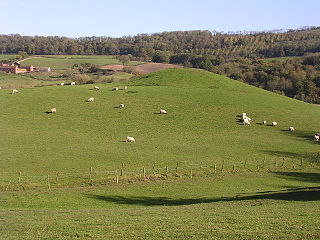
Ham Castle is located in Worcestershire at the bottom of a wooded escarpment, within the parish of Clifton-upon-Teme, about 1 mile (1.6 km) east of the village of Clifton-upon-Teme and 4 miles (6.4 km) south of Great Witley.

Horsford Castle is situated in the village of Horsford, 6 miles to the north of the city of Norwich.
Ardley Castle was a castle to the southwest of the village of Ardley, Oxfordshire, England. At present only some of its ruins, most notably an oval enclosure one hundred yards (91 m) in diameter, with a shallow ditch with an average depth of three feet (0.91 m), a derelict moat and the earthworks remain.

While there are many castles in South Yorkshire, the majority are manor houses and motte-and-bailey which were commonly found in England after the Norman Conquest.

A ringwork is a form of fortified defensive structure, usually circular or oval in shape. Ringworks are essentially motte-and-bailey castles without the motte. Defences were usually earthworks in the form of a ditch and bank surrounding the site.

Manor Farm is a 22-acre (8.9 ha) historic site in Ruislip, Greater London. It incorporates a medieval farm complex, with a main old barn dating from the 13th century and a farm house from the 16th. Nearby are the remains of a motte-and-bailey castle believed to date from shortly after the Norman conquest of England. Original groundwork on the site has been dated to the 9th century.
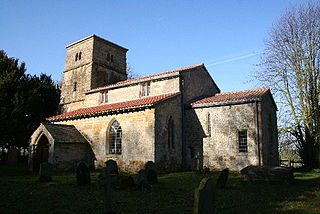
Kingerby is a village and former civil parish in the West Lindsey district of Lincolnshire, England. It is situated 5 miles (8.0 km) north west from the town of Market Rasen. The hamlet of Bishop Bridge lies about 1.5 miles (2.4 km) to the south-west.
















